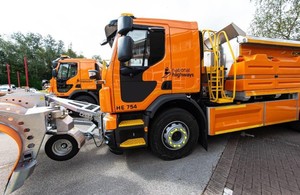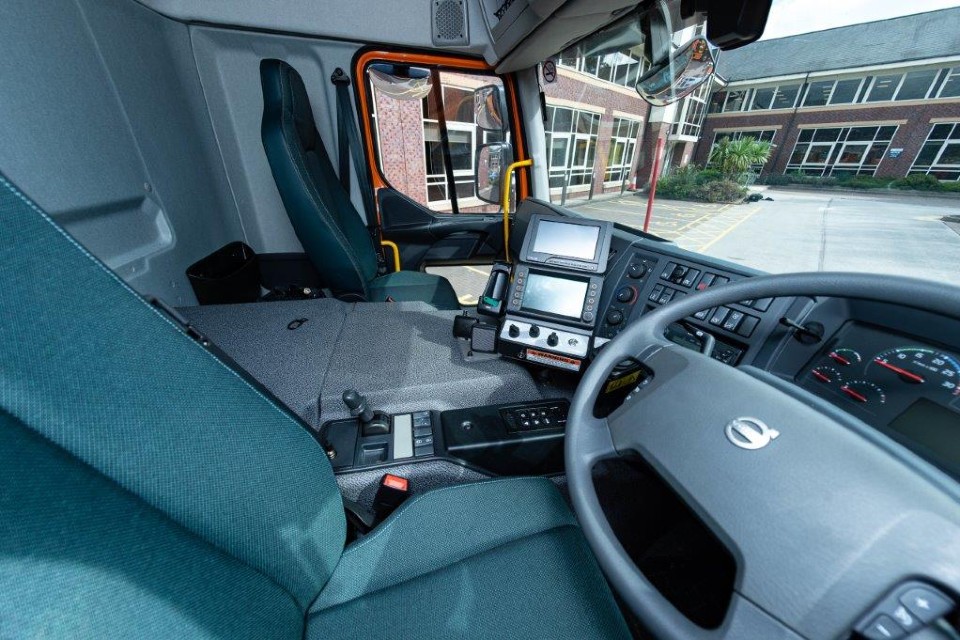120 new gritters keep drivers safe this winter
A total of 120 brand new gritting vehicles will be delivered to National Highways this year helping keep traffic moving this winter.

The new vehicles are part of a two-year roll-out of state-of-the-art gritters across the country with a further 132 more to come for winter 2022-23.
Regions receiving new gritters this year are:
- Kent, Surrey, West and East Sussex – 36 vehicles
- Leicestershire, Northamptonshire, Derbyshire, Nottinghamshire, Lincolnshire, part of Warwickshire, Rutland and part of Oxfordshire – 47 vehicles
- Bedfordshire, Hertfordshire and parts of Suffolk and Cambridgeshire – 28 vehicles
- West Midlands, Shropshire, Worcestershire, Herefordshire, Warwickshire, Staffordshire and part of North Gloucestershire – 7 vehicles
- Cornwall, Devon, Somerset, Avon, Wiltshire and Gloucestershire – 2 vehicles
Duncan Smith, Acting Executive Director of Operations, was at the National Highways offices in Nottingham to welcome the new vehicles.
He said:
The new vehicles are an impressive sight and this year’s roll out once again demonstrates our commitment to keeping drivers safe throughout the winter months.
They include state of the art technology allowing us to treat the roads up to a maximum of 50mph, 10mph faster than earlier models. We want everyone to travel safely on our roads and ask that drivers take extra care near gritters, leave a safe distance, overtake gritters carefully when it is safe to do so and at a reduced speed.
When the wintry weather arrives our winter teams across the country will be ready to work around the clock to keep traffic moving.

Duncan Smith, Acting Executive Director of Operations (pictured right) received the keys from Stephen McKeown, Managing Director of Romaquip, for the new 26-tonne Volvo gritters which will be patrolling the network this winter.
The new vehicles are equipped with technology which allows gritting routes to be uploaded directly into the vehicle, helping advise drivers where to go, which lanes to treat and drive in but also specific information to consider such as bridges, or other road features.
They meet the latest EU emission standards for heavy-duty CI (diesel) engines known as Euro 6 which are focused on reducing harmful exhaust emissions, ensuring National Highways procure the cleanest and most efficient vehicles available.

Inside the new high-tech gritter cabs
Over the last four years National Highways has replaced 311 gritters helping keep roads open and people moving in severe weather. Phase one of the roll out started in 2018 with 34 new vehicles delivered in the east of England. In 2019, 64 were put into operation in the North East and South East. And last year, 93 took to the roads in the North West and South West. This year’s 120 new gritters marks the start of phase two of the fleet refresh.
To help keep drivers on the move this winter, National Highways has 1,300 specially trained gritter drivers and 535 gritters available which have all gone through a summer service. There are 127 depots based at strategic points across the network, 23 snow blowers which can remove up to 2,500 tonnes of snow per hour and National Highways will be storing over 280,000 tonnes of salt.
To monitor the weather around the clock National Highways has around 250 weather stations located across its 4,400 miles of motorways and major A roads. Overhead warning signs can also be used to inform motorists of severe weather.
When severe weather is forecast drivers should follow this advice:
- In snow and ice, drivers should stick to the main roads where they can and only travel if necessary - drivers are also encouraged to make sure they have a snow kit in their vehicle, including an ice scraper and de-icer, warm clothes and blankets and sunglasses to cope with the low winter sun.
- In high winds, there’s a particular risk to lorries, caravans and motorbikes, so drivers should slow down and avoid using exposed sections of road if possible.
- In heavy rain, drivers should keep well back from the vehicle in front, gradually ease off the accelerator if the steering becomes unresponsive, and slow down if the rain and spray from vehicles makes it difficult to see and be seen.
- In fog, drivers should switch on their fog lights and not use lights on full beam as the fog will reflect the light back. If you really cannot see, you should consider finding a safe place to stop until it is safe to continue.
Drivers are advised to follow messages on the overhead signs and listen to radio updates.
Further information is available on Travelling in winter web page.
Further information can be found by visiting the Travel updates page, and by following @highwaysnwest @highwaysneast @highwaysseast @highwaysswest @highwayseast @highwayswmids, @highwaysemids @highwaysyorks on Twitter or calling the National Highways Information Line on 0300 123 5000.
General enquiries
Members of the public should contact the National Highways customer contact centre on 0300 123 5000.
Media enquiries
Journalists should contact the National Highways press office on 0844 693 1448 and use the menu to speak to the most appropriate press officer.